Dragon SpX-12 Cargo Overview
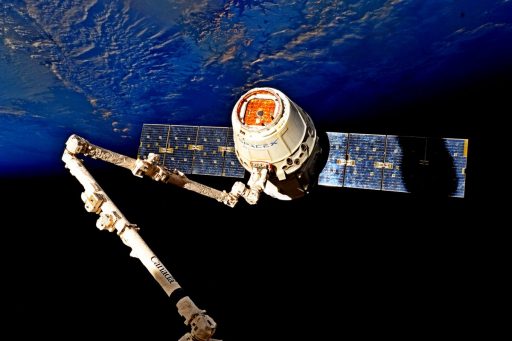
Dragon SpX-12 is the twelfth operational mission of the SpaceX Dragon under NASA’s Commercial Resupply Services contract, lifting off in August 2017 as the third Dragon flight of the year to keep up a steady chain of supplies and experiments headed to the International Space Station and its six crew members. The Dragon SpX-12 mission delivers dozens of experiments supporting a total of 330 experiments underway during ISS Expeditions 51 and 52 and the spacecraft also carries a high-profile astrophysics payload that aims to measure the highest-energy particles arriving from the distant universe.
The SpX-12 mission uses the last newly built Dragon vehicle with all subsequent Dragon missions under CRS-1 (through SpX-20) to be performed by previously flown and refurbished Dragon spacecraft. This facilitates a transition at SpaceX’s production line from the Dragon 1 spacecraft to the Dragon 2 vehicle that will handle missions under the Commercial Crew Program as well as the CRS-2 contract round that guarantees SpaceX at least six cargo missions through 2024.
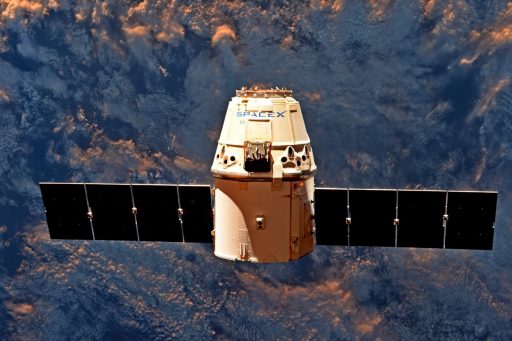
The first Dragon re-flight was carried out earlier in 2017 on the SpX-11 mission that flew the Dragon C106 vehicle which had previously spent time on orbit for the SpX-4 mission back in September/October 2014. The mission was trouble-free and cemented plans of flying the SpX-13 through 20 missions with refurbished Dragons.
SpaceX designed the Dragon cargo craft to be at least partially reusable in that their pressure vessel and propulsion system were baselined for multiple mission cycles. Some components like the trunk section and solar arrays are discarded before re-entry and have to be built new for every Dragon mission and other components like the heat shield, some external panels and avionics components are also replaced between flights.
The Dragon SpX-12 mission is carrying a total cargo upmass of 2,910 Kilograms to the International Space Station, comprised of 1,258 Kilograms of external cargo in the spacecraft’s trunk section and 1,652 Kilograms of pressurized cargo to be transferred to ISS by the crew.
- Total Cargo: 2,910 Kilograms
- Pressurized Cargo (with packaging): 1,652 Kilograms
- Science Investigations: 916 kilograms
- Vehicle Hardware: 339 kilograms
- Crew Supplies: 220 kilograms
- Computer Resources: 53 kilograms
- Spacewalk Equipment: 30 kilograms
- Unpressurized Cargo: 1,258 kilograms
- CREAM (1,258kg)
- Pressurized Cargo (with packaging): 1,652 Kilograms
Dragon enjoys a special role within the Space Station’s visiting vehicle fleet as the only craft capable of returning meaningful cargo downmass to the ground (aside from the Russian Soyuz that can carry a few dozen Kilograms of cargo when flying with a full crew of three).
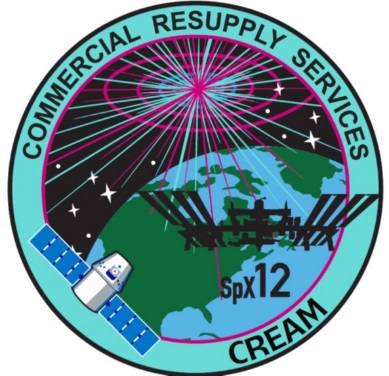
Installed in the Trunk Section of the SpX-12 Dragon is CREAM, the Cosmic Ray Energetics and Mass Instrument, that will take up residence on the Station’s porch, the Exposed Facility of the Kibo Module to measure ultra-high energy particles to further knowledge in high-energy astrophysics, hoped to answer long-standing questions on peculiarities of the cosmic spectrum.
The Dragon will launch with three powered Polar Freezers holding various biological experiments to be performed on ISS, a Rodent Habitat Transporter Unit holding 20 mice and a JAXA Mouse Habitat Unit hosting another group of rodents. Both rodent experiments flown by SpX-12 will feature a live return of the mice for post-flight testing on the ground. For return, Dragon will hold four powered Polars to return samples from orbit, providing a welcome opportunity to empty out the Station’s lab freezers that hold everything from crew member samples & plant parts to mouse organs and samples from the ISS environment.
CREAM – Cosmic Ray Energetics and Mass
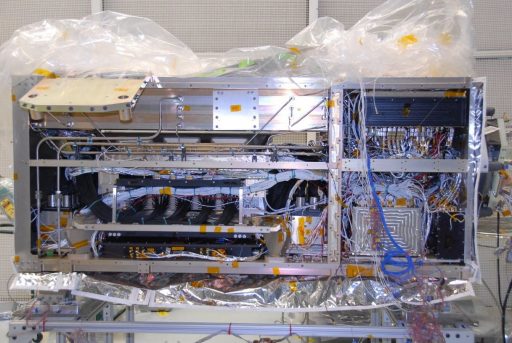
CREAM – the Cosmic Ray Energetics and Mass Instrument – is an energetic particle detector taking up residence outside the International Space Station to directly sample ultra-high-energy particles from outside the Solar System that exceed the energies achievable with any current-generation particle accelerator on Earth and hold clues on the composition of the universe.
The CREAM experiment is hoped to answer the century-old question on what gives cosmic energies such tremendous energies (1,000 Tera-Electronvolt +) and how does that affect the composition of the universe. CREAM can measure particles at higher energies than the Space Station’s high-profile astro-physics payload, the Alpha Magnetic Spectrometer 2, and is therefore hoped to reveal what causes a ‘knee’ or decline in the cosmic energy spectrum around a thousand trillion electron-volts where particle theory would not predict such a decrease.
>>Detailed Overview of the CREAM Instrument
Satellites
The Dragon SpX-12 mission is carrying numerous satellites to the International Space Station including the Kestrel Eye 2M microsatellite and a series of CubeSats – the ELaNa 22 CubeSats flown by NASA and commercial satellites to be deployed from ISS. Click the links below for detailed technical information on the SpX-12 CubeSats:
- Kestrel Eye 2M (Military Reconnaissance, Tech Demo)
- ASTERIA (Tech Demo, Exoplanet Science)
- Dellingr (Tech Demo, Heliocentric Science)
- OSIRIS-3U (Space Weather)
Spaceborne Computer
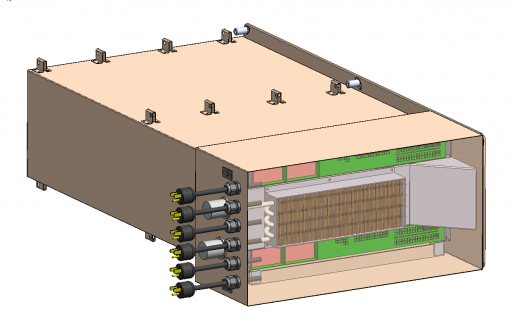
The Spaceborne Computer, more formally known as the “High-Performance Commercial Off-The-Shelf Computer System on the ISS,” will complete a year-long experiment of a COTS computer system on ISS to evaluate its performance in the challenging space environment with particular focus on the space radiation environment. COTS computers, while not radiation-hardened like operational systems on ISS or other satellites, can be programmed to respond to radiation by lowering operating speeds (powering down) and the Spaceborne Computer provides a cost-effective way of studying methods of using software to protect space-based computers without needing as much radiation hardening as current systems are using.
Presently, the Space Station’s main computers in charge of command and control functions are using Intel i386 processors from the 1990s. For ISS, this is perfectly fine since all critical systems are monitored round the clock by flight controllers who can make critical decisions and work with the crew in case of any problems. For missions venturing out into the solar system, the task of making critical flight decisions will have to be made by advanced computer systems and artificial intelligence as humans on Earth can no longer be directly in the loop due to communication delays that can be anywhere from a few minutes to several hours.
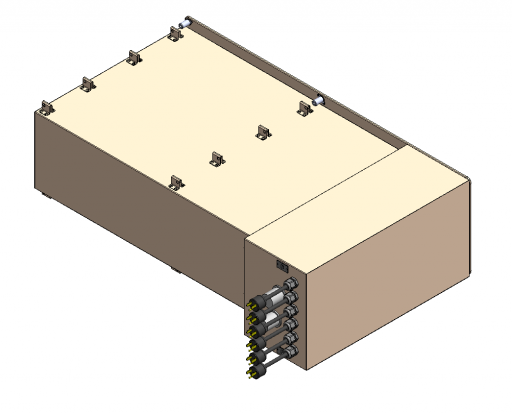
NASA partnered up with Hewlett-Packard to develop a space-based ‘supercomputer’ to take a first step in high-performance computing in space. Although the Spaceborne Computer is still a generation behind ground-based systems, it represents the most powerful computer sent into space to date. The computer is capable of 1012, floating point operations per second (1 teraflops).
The Spaceborne Computer, comprising two identical high-performance COTS systems, will be installed in the Destiny lab and run a series of computing tasks and data-intensive applications. Radiation effects on the computer are determined concurrently with detecting/analyzing/adapting to data, quickpath interconnect (QPI) internal and FDR external errors. Power consumption is constantly monitored and dynamically tuned on one machine to reduce power during high radiation periods while the other remains in a maximum and steady power/performance config to see whether it degrades quicker than the software-throttled unit. An identical set of computers will complete identical processing tasks on Earth to act as a control.
The computers will generate around 5.4MB of performance data per day that will be stored on solid-state devices and downlinked on a daily basis. At the end of the year-long mission, the two spaceborne units will return to Earth to undergo post-flight studies comparing the throttled and non-throttled unit to one another and the Earth-based controls.
Protein Crystal Growth 7
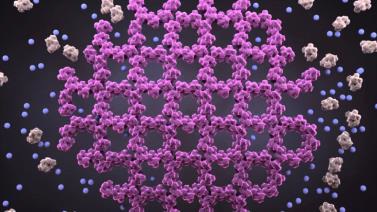
The Protein Crystal Growth 7 experiment, operated by CASIS and the Michael J. Fox Foundation, goes by the full name of “Crystallization of LRRK2 Under Microgravity Conditions” and attempts to utilize the microgravity environment to grow larger version of the LRRK2 protein which has been implicated in Parkinson’s disease. Large LRRK2 crystals will enable scientists to fully understand its structure and its role in Parkinson’s, thus helping in the development of therapies against this target protein.
The use of protein crystallography requires high-resolution diffraction-quality crystals of a protein in order to be able to model the three dimensional structure of the molecules. Many protein molecules synthesized on Earth fall short of that requirement, allowing only partial structural information to be extracted. For targets in which high-resolution crystal structures are needed, production of crystals in the space environment may be a solution.
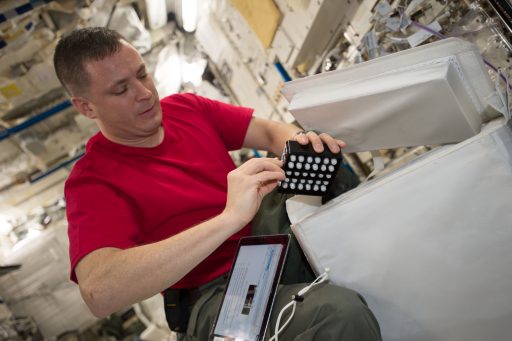
Growing Protein crystals in space yields larger, more uniform and pristine crystals than those grown on Earth due to the absence of a number of issues such as sedimentation and shear forces, preventing the growth of large molecules. In case of LRRK2, Earth-grown crystals are too small and compact to study with current laboratory methods despite ten years of efforts to map out the protein’s structure.
The PCG7 study will grow LRRK2 crystals aboard the Space Station and return them to Earth to undergo analysis using x-ray diffraction and neutron diffraction studies. This will yield complete crystalline structure information of the target protein and help inform potential inhibitor therapies that could prevent, slow or even stop the progression of Parkinson’s disease.
The PCG7 experiment employs the Microlytic Crystal Former Optimization Chip (16 Channel) plate – a commercial product that is similar to previously flown PCG multi-channel/well plates. The hardware is launched in cold stowage to remain frozen until being transferred to the ISS environment to start the three-week nucleation and crystallization process. Return to Earth is completed in refrigerated storage.
Lung Tissue

“Effect of Microgravity on Stem Cell Mediated Recellularization (Lung Tissue)” aims to use the microgravity environment to test methods for growing new lung tissue. Exploiting state-of-the-art bio-engineering techniques, the Lung Tissues experiment will use different types of lung cells grown in a specialized framework that provides them with critical growth factors to allow for an assessment on how gravity affects cell growth and specialization. Bioengineered human lung cells can be used as a predictive model of human responses for the study of lung development, lung physiology and disease pathology.
The Lung Tissue study provides the first comprehensive look at what happens to lung function and repair during prolonged exposure to the space environment, characterized by the absence of gravity, hyperoxia and elevated radiation exposure. In-vitro studies of human lung mimics can simplify complex mechanisms of pathogenesis and reveal the processes involved in the development of various lung diseases. Lung mimics can also be used for assessments of drug or chemical toxicity by biotechnology and pharmaceutical companies, allowing for rapid and risk-free testing of new chemicals, lowering the cost for developing new drugs.
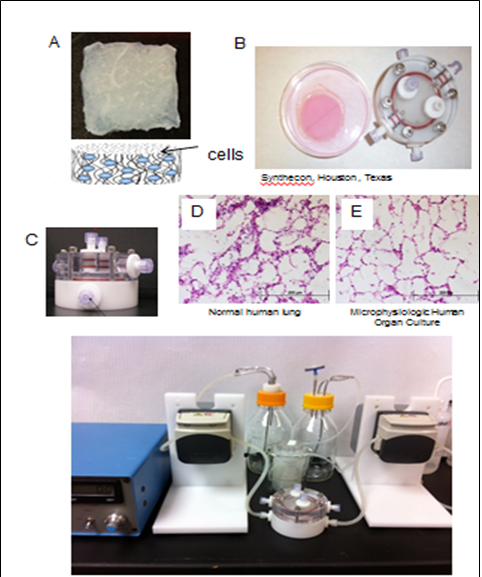
The microphysiologic human organ culture model (MHOC) developed by the research team consists of lung epithelium and endothelium which allows for comprehensive in-vitro studies of lung physiology, response to trauma and development of lung disease. The lung mimics are created by seeding progenitor cells (that still have to differentiate into specific cell types) onto an accellular lung scaffold (colloidal crystals + growth factors) with micro- or nano-structures which give rise to the appropriate cell-to-cell interactions leading to lung tissue formation with particular focus on the alveolar-capillary junction that includes both epithelial and endothelial cells. MHOC lung mimics can include epithelial type I & II cells, smooth muscle cells, fibroblasts and mesemchymal stem cells (MSC) as well as other progenitor cells.
The MHOC models can be constructed to include cell phenotypes of interest for specific studies such as MSCs and macrophages which will be used by Lung Tissues to examine the influence of spaceflight on human immune responses which are in part driven by macrophages and MSCs in the lung. There currently is no knowledge on the influence of spaceflight on the function of stem or progenitor cells or MSCs, although they play a major role in modulating human immune responses and support the generation of new lung tissue. MSCs help in tissue repair, modulate immune response and therefore are prime candidates for clinical applications in regenerative medicine.
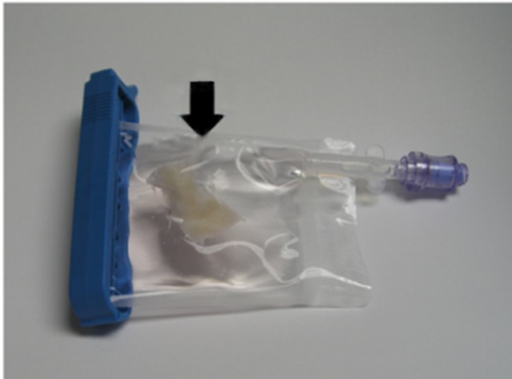
Lung Tissues addresses the primary hypothesis that spaceflight alters the ability of human lung progenitor cells and macrophages to function due to the absence of gravity and elevated radiation levels. The space environment may affect the proliferation and self-renewal capacity of MSCs which hinders lung tissue repair and immune response. A future goal of the study is to work out strategies for modulating MSC or macrophage responses in space to decrease health risks in space flight and potentially develop treatments for immunosuppressive conditions on Earth.
The Lung Tissue experiment rides to ISS in BioCell Habitat containers conditioned at 37°C and charged with 5% carbon dioxide. On ISS, the cultures are placed into the SABL with a control unit to supply the required thermal environment and CO2. The Station crew will complete periodic sampling of the cultures, taking a 4.5ml sample from the culture bags and freezing it at -80°C for the remainder of the flight and then at -20°C or colder for return aboard the SpaceX Dragon. The cells remaining in the bags at the end of the ~5-week mission will be chemically fixed and returned in cold bags at under 4°C.
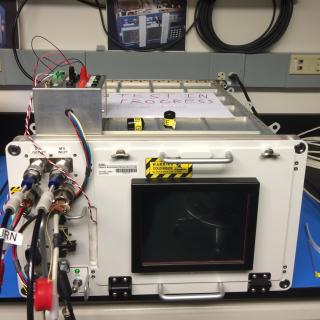
The Space Automated Bioproduct Lab (SABL) is a new space life science facility to be deployed on the International Space Station for a wide variety of research ranging from fundamental, applied and commercial space life sciences research to education-based investigations. The Space Automated Bioproduct Lab is an incubator facility to host cell culture and other biological experiments, supporting bacteria, yeast, algae, fungi, viruses, animal cells and tissues and small plant and animal organisms.
SABL provides an experiment volume of 22.8 liters suitable for 18 Group Activation Packs. The system measures 41.9 by 27.9 by 19.4 centimeters in size and it can support temperatures of –5°C to +43°C, offering a number of accommodations that make the facility easy to use for Astronauts onboard ISS such as a front door that can be opened without removing any connectors for a simple exchange of payloads or payload trays. Thermal control is provided by a water cooling loop and electrical heaters.
The facility is controlled via a high-resolution color touchscreen, the first of its kind deployed on ISS. Data is delivered to and from the facility using USB 2.0, Ethernet and A/D In-Out interfaces. Within the sample chamber, experiments can be documented using high-definition imagery and scanning, high-resolution imaging.
Rodent Research 9
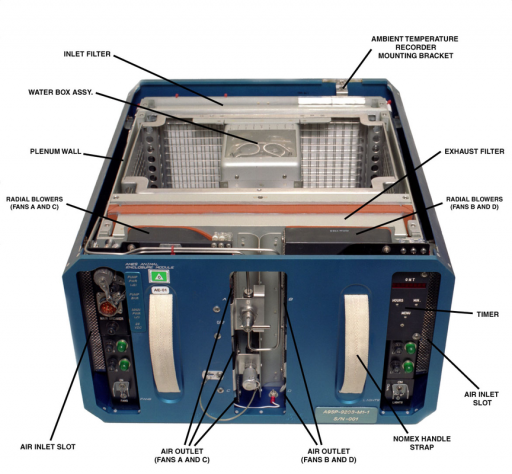
Rodent Research 9 has the full name “Effects of Spaceflight on the Musculoskeletal and Neurovascular Systems and Their Implications in Mice” and studies how the microgravity environment affects the immune systems, muscles and bone structure of rodents over an extended stay in space. The experiment, unlike some of the previous Rodent Research studies, will use a live return of the mice so that scientists can study how their time in Zero-G affected their various bodily systems and tissues.
RR-9 is actually the sixth Rodent Research flight following up on a proof-of-concept mission on SpX-4 and rodent science missions on SpX-6, 8, 10 and 11 that looked at various research topics such as space-induced rise in intracranial pressure, antibody response, and methods for prevention of skeletal muscle atrophy and osteoporosis. The RR-9 experiment takes a multi-pronged approach to look at space-related stress factors and their effect on the Musculoskeletal and Neurovascular Systems of vertebrates acting as model organisms for humans.
Rodent Research 9 addresses three objectives: a) determine the effects of long-duration space flight on cerebral arterial and venous tone, constrictor responsiveness, mechanical stiffness / gross structure, and capillary endothelial cell structure and lymphatic contractile activity; b) study the retinal micro-vascular and tissue remodeling that impact visual function and identify factors and cellular mechanisms that trigger space environment-induced alteration of cell-to-cell interaction in the function of the blood-retinal barrier; and c) determine the scope of knee and hip joint degradation undergone during long-duration space flight.
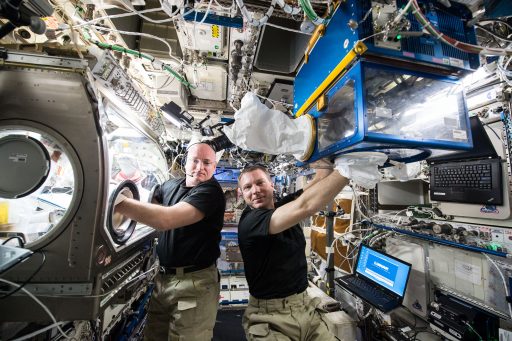
Given the genetic and physiological similarities between mice and humans, this experiment can provide insights into how human tissue and systems change under space-related stress factors. The research also contributes to disease treatment and prevention through revealing pathways of cellular degradation in human circulatory, immune and nervous systems. Ideally, the study will help in the development of drugs and other regimens to mitigate adverse health effects arising from long-term space travel.
Rodent Research 9 involves 20 mice flown to ISS in the Transporter Unit before taking up residence in the ISS-based Habitat Unit for the duration of the 30-day mission. Daily video downlink is needed to monitor the health of the animals. At the end of the rodents’ stay on ISS, they will be transferred into a clean Transporter Unit for return to Earth aboard Dragon.
Microbial Tracking 2
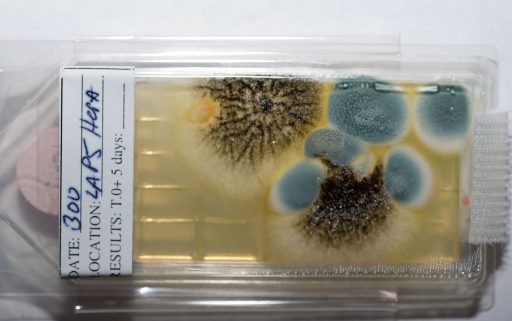
The Microbial Tracking 2 study will acquire crew samples pre-flight, in-flight and post-flight as well as air and surface samples from various locations of the International Space Station to observe which bacteria, fungi and viruses are present and what impact they may have on the crew’s well being. The overall goal of the research is to catalog and characterize potential disease-causing microorganisms aboard ISS and their impact on crew health.
This collection will last for at least two ISS increments to allow scientists to look at the types of microbes that can survive in the space environment and study their changes over time. This data is valuable for the assessment of risks to crew health and it also allows a close look at the way microbes adept in space as compared to mechanisms known from Earth-based studies.
Experiment data from MT-2 will go down to the cellular level to identify reactions that may be occurring in space but not on Earth which can provide helpful information for the development of antibiotics and antimicrobial agents. The experiment also serves as validation for omics technology in the screening for microbes and identification of those that may be present.
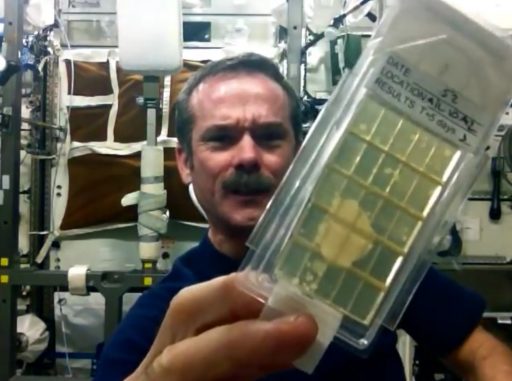
MT-2 aims to better understand risks to crew health in a closed environment for infection and illness, assess risk to fouling of clean air supplies and contamination of fluids and food, compare the microbial communities on ISS and on Earth in normal and extreme environments, identifying specific microbes that flourish in the space environment and conduct a study of the adaptation of microbes to the space environment.
Three ISS crew members will participate in the study, collecting baseline data at launch minus six and three months (four sampling operations over one week), in-flight data at L+ 1-2, 2-4 months and return minus ten days and post-flight data at R+1 day, 1 month and 6 months. Samples taken include saliva and oral swabs, skin swabs from forehead, armpit, retroauricular crease, antecubital fossa, naval region and nasal cavity.
The experiment uses air and surface samples collected from the various ISS modules, stored at room temperature and returned to Earth within two weeks of acquisition. Sample methods of MT-2 include adhesive tapes, swabs, contact slides, wipes, gelatin air filters and used gloves. Eight specific locations for surface sampling and six air sampling points have been selected – the zero-G stowage rack (ZSR) surface and dining table inside Unity (Node 1); crew quarters (CQ3) interior port wall inside Harmony (Node 2); overhead hatch area of cupola, rack next to waste and hygiene compartment (WHC), and foot platform of the advance resistive exercise device (ARED) inside Tranquility (Node 3); the ZSR surface inside Leonardo PMM; and the rack front near portable water dispenser (PWD) inside Destiny (Laboratory).
BRIC-22 & LED
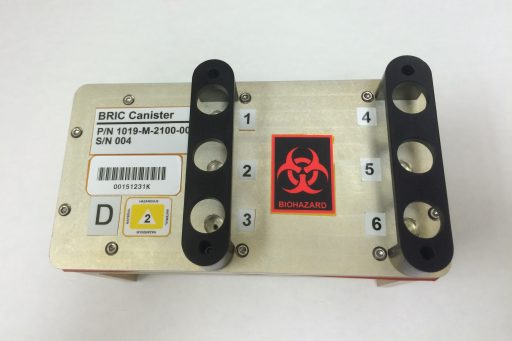
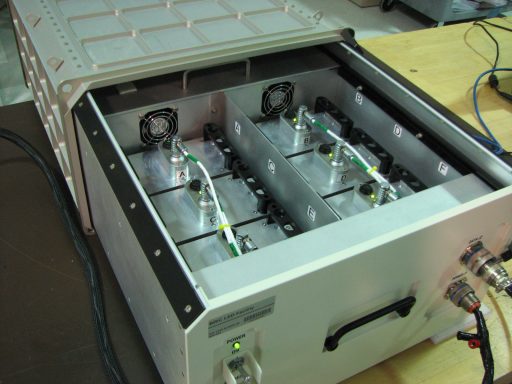
The Biological Research in Canisters (BRIC) utilizes standardized experiment containers on ISS to conduct experiments with minimal crew time requirements. BRIC-22 takes previous studies as a basis that identified the protein AtIRE1 which acts as a master regulator and, with additional gene regulators, helps protect plants from space-induced stress. The BRIC-22 experiment features eight variants of thale cress to determine how AtIRE1 performs its protective function by identifying the genes targeted by the protein and examining specific triggers of AtIRE1 activity.
The BRIC-22 experiment travels to ISS in a double cold bag and is then unstowed to allow the plant cultures to cultivate for 14 days before chemical fixation by the crew. Fixed samples are frozen at -80°C and return in Dragon cold stowage for an expedited return to Michigan State University for RNA sequencing and a quantitative analysis of the marker gene expression via the Polymerase Chain Reaction.
BRIC-LED is a technology validation of a new BRIC unit that can perform biological investigations in a closed device with artificial illumination of samples via LEDs to expand the existing BRIC hardware and analyze the behavior of a range of organisms as a function of illumination (wavelength & intensity). Four different wavelengths of LEDs will be available for each of the 60mm Petri dishes (blue, red, far-red and white) and the intensity or on/off cycling can be configured per each experiment’s requirements. The BRIC-LED hardware also logs temperature, LED status, canister pressure and accelerometer data as auxiliary experiment data.
ACE-M2R
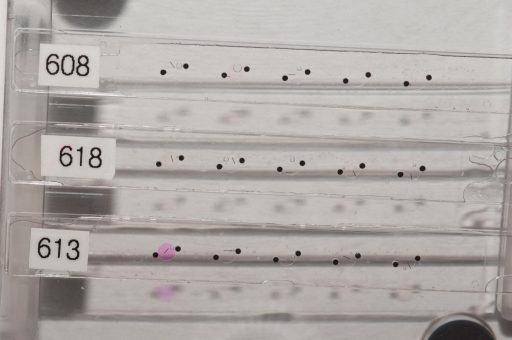
The Advanced Colloids Experiment (ACE-M2R) is a re-flight of ACE-M2, studying the microscopic behavior of colloidal liquids and gases separating from each other using colloid rich liquids and colloid poor gases near their critical points (no sedimentation) where there is no clear distinction boundary between the two phases. Previous ACE experiments looked at long-term colloidal phenomena transpiring over a period of weeks while ACE-M2R will seek to explore micro-scale events on short time scales.
Colloids are micron-scale solid particles suspended in a fluid (gas or liquid) with particle sizes small enough so that thermodynamics drives their behavior. Removing gravity takes away sedimentation processes and exposes the thermodynamic processes responsible for phase transitions and other mechanical phenomena. The particles have to be large enough to be probed by light, using scattering and microscopy techniques to follow particle motion and density patterns so that single-particle knowledge can be obtained to characterize an array of physical processes such as crystallization, gelation, phase separation, and dynamical arrest in glasses.
The ACE-M2R experiment upgrades the original ACE-M2 experiment from a 2D measurement to 3D using the upgraded Light Microscopy Module (LMM).
Colloidal mixtures are found abundantly in consumer products on Earth and experiments such as this are needed to improve their quality by development if stabilizers to increase a product’s shelf life before separation phenomena set it.
Mouse Habitat Experiment
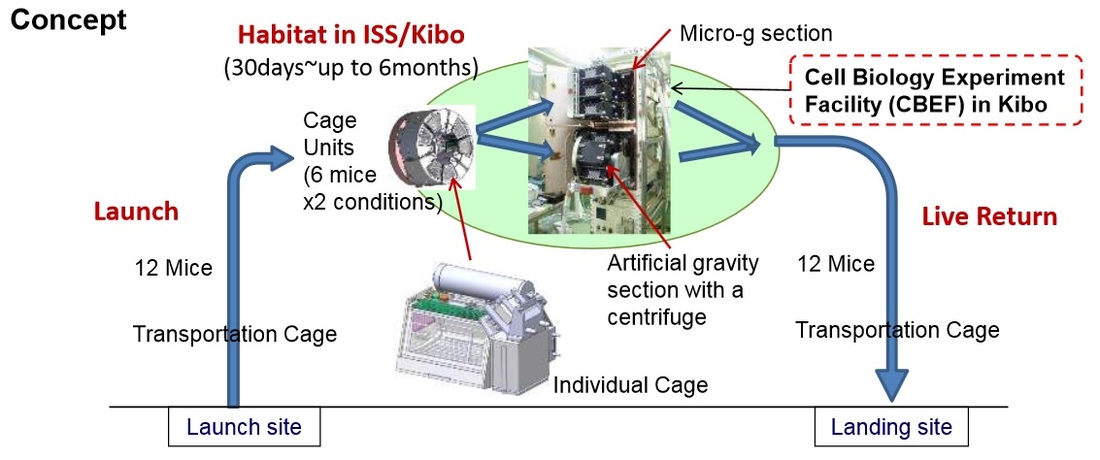
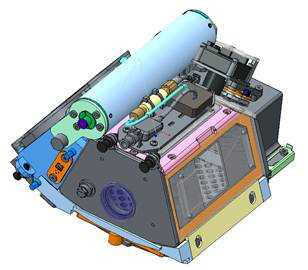
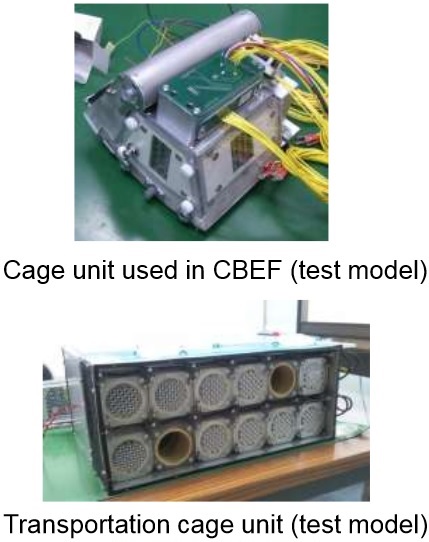
The Japanese Mouse Habitat Experiment in some ways is similar to the U.S.-led Rodent Habitat set up on the Space Station in 2014, however, there are a number of significant differences including the use of artificial gravity and the accommodation of one mouse per cage for individual studies of behavioral changes. The Mouse Habitat Experiment consists of two major segments, the main Onboard Cage Unit for the accommodation of mice for 30 to 180 days and Transportation Cage Unit that accommodates the animals for up to ten days from launch to transfer to ISS and from the end of the ISS-based experiment to the return to Earth aboard a visiting vehicle.
Flying rodents to ISS provides an extremely valuable opportunity for a variety of studies from the mechanisms of bone loss in space over the adverse effects of space radiation to aging studies as well as a range of other studies looking at changes undergone by cells, tissues and organ systems as a result of prolonged exposure to space.
The Mouse Habitat will be set up in the Cell Biology Experiment Facility CBEF in the Kibo module that provides two research sections. One Cage Unit facilitating six mice will be set up in the Micro-g section where mice experience the full space environment (microgravity, radiation) and the artificial gravity section that makes use of the short-arm centrifuge of CBEF which had so far only been used to expose plants to an artificial gravity environment, but as ground studies have shown, the centrifuge is also suitable to create a gravity environment for small mammals. Having six mice exposed to artificial gravity takes the microgravity environment out of the equation so that a comparison between the micro-g experiment and artificial-G experiment can highlight the adverse effects caused solely by radiation and those caused by microgravity alone. This will be the first long-term experiment involving mammals in an artificial gravity environment.
Each cage unit, around 15 centimeters in diameter includes systems to provide the mice with food and air circulation. Sensors installed within the cages record the temperature and humidity environment as well as carbon dioxide and ammonia content within the cage units. Cameras are used to document behavioral changes for the entire duration of the experiment.
The Mouse Habitat Experiment is set up for a live return of all 12 animals involved in a single experiment run, sparing the ISS crew the procedures associated with dissecting and preserving the specimens which will be completed by skilled researchers on the ground with access to more advanced analysis systems to examine collected samples down to a cellular and biochemical level.
VEGGIE – Veg-03 D, E & F
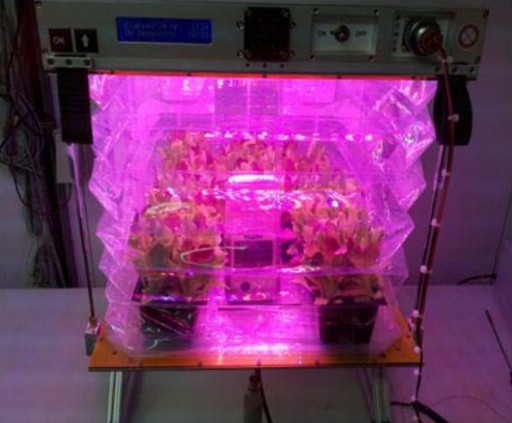
Veg-03 marks the third operational deployment of the VEGGIE Plant Growth Unit that was first used in the first half of 2014 to grow red romaine lettuce plants as part of a proof of concept of the Plant Growth Unit including two different sizes of arcillite, a calcined clay media in which the plants were grown.
Veg-01 provided valuable data in the form of returned water samples and root pads, imagery acquired in orbit of the growth process, and plant samples that were brought back to Earth. This data helped investigators assess the two different growth media with respect to water and root distribution within the different sized particles to chose media for future Veggie missions.
Furthermore, samples returned to Earth provided information on the microbial load of the plants to assess their safety for potential crew consumption and photographs taken over the course of the experiment allowed scientists to asses growth rate and plant health.
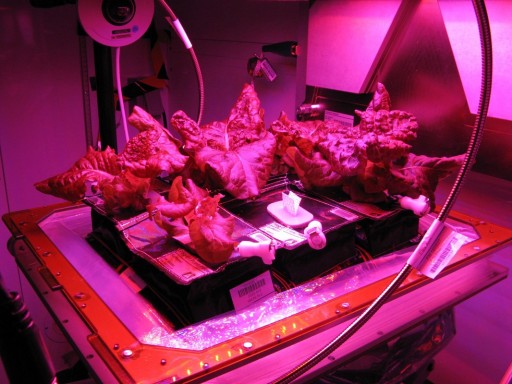
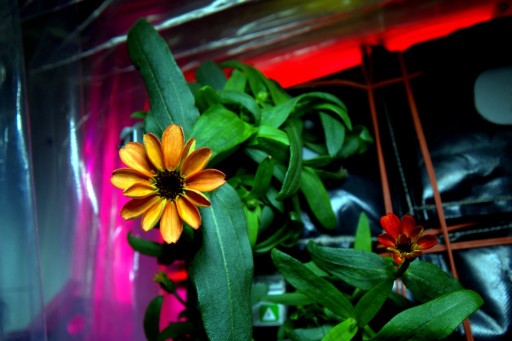
Additionally, two data loggers kept track of temperature and humidity within the Plant Growth Unit and questionnaires were performed by the crew to gather information on possible improvements of Veggie experiment procedures.
Although the overall Veg-01 experiment was a success, a number of deficiencies with regard to the plant pillows and the water delivery systems were identified leading to modifications made to the pillows and watering procedures that will be tested by Veg-03, also introducing a different crop with different water requirements.
Ground testing of the Plant Growth Facility showed a very low microbial contamination of plants that were grown within it and the Veg-01 experiment samples also showed a low microbe level with no specific pathogens being detected by ground-based testing. Assessments were conducted by microbiologists, flight surgeons and space food technicians who concurred that the crew should be able to consume the fresh produce with precautionary sanitizing using on-orbit Prosan wipes.
In 2015, the Space Station crew got their first taste of home-grown lettuce harvested from the Veggie Plant Growth Unit. Another 2015 study provided the crew with a touch of color when the first flowers grown on ISS were harvested by Astronaut Scott Kelly who also provided valuable insights into changes of experimental and operational protocols necessary for future Veggie experiment runs.
The overall aim of the Veg-03 study is to deliver more data on the performance of the Plant Growth Unit and the planting pillows. Veg-03 D, E, F represents three sets of six plant pillows with Mizuna mustard, Waldmann’s green lettuce, and Outredgeous red romaine lettuce seeds,
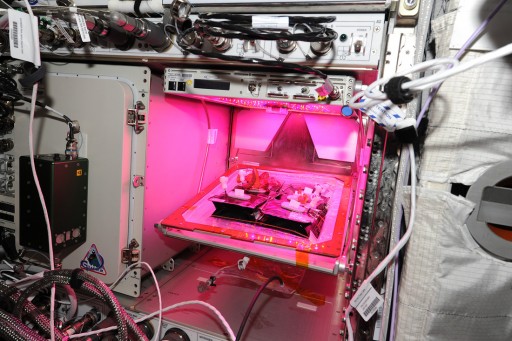
The Veggie experiment facility provides lighting and nutrient supply and is capable of supporting a variety of plant species that can be cultivated for educational outreach, fresh food and even recreation for crewmembers on long-duration missions. Thermal control is provided from ISS in-cabin systems and the carbon dioxide source is the ambient air aboard ISS.
Plants grown in the Veg-03 facility will be observed to determine how plants sense gravity and how they respond to microgravity. Serving as a pathfinder, the plants grown as part of VEGGIE will be harvested and studied before being cleared for consumption by crew members in orbit. The VEGGIE facility is the largest volume available aboard ISS for plant growth, which will allow the study of larger plants that could not be grown in previous experiments.
Veggie uses a plant growth chamber using planting pillows and an LED bank to provide lighting. Ground testing of the pillow planting concept led to the selection of growth media and fertilizers, plant species, materials, and protocols. The facility weighs 7.2 Kilograms and measures 53 by 40 centimeters and permits a maximum growth height of 45 centimeters. The root mat has a growing area of 0.16m² with a 2-liter fluid reservoir.
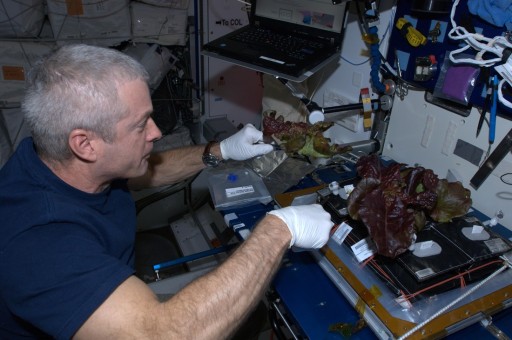
The system draws 115W of peak power and its LED banks can support adjustable wavelengths, light levels and day and night cycles to match the biological needs of the plants. A transparent teflon cover allows viewing of the plants. The plants will be photographed regularly to assess plant growth rates and health. Tissue samples will provide information on possible growth anomalies when being compared to ground controls. Environmental data will be provided by a data logger that measures temperature, humidity and pCO2.
The first studies performed with VEGGIE will also provide microbial samples of the plants and pillows to assess the level of microbial contamination and implement corrective measures if needed. For most species, microbial contamination levels will be well within limits and pose no threat to the crew. Other species that naturally have higher levels of microorganisms may need a sanitation method which must be developed and tested as part of the experiment. Growing plants in space provides crewmembers with fresh foods to supplement their diets, as well as a positive effect on morale and well-being.
CASIS National Laboratory Payloads
Activity of Mutated Drosophila in Microgravity
Visible differences in flight between normal and mutant Drosophila flies will be monitored to identify if there are any positive differences in movement by placing the flies in a microgravity environment. The International Space School Educational Trust (ISSET) in partnership with King’s College in London lead this endeavor.
Cactus-Mediated Carbon Dioxide Removal in Microgravity
Oxygen output and carbon dioxide intake of a cactus sempervivum will be measured and evaluated to provide information on how to improve the efficiency of carbon dioxide regulation of long-term space travel. The ISSET is in partnership with King’s College in London on this investigation.
Conversion of Adipogenic Mesenchymal Stem Cells into Mature Cardiac Myocytes
Conversion of Adipogenic Mesenchymal Stem Cells into Mature Cardiac Myocytes uses the microgravity environment of space to examine how stem cells differentiate into specialized heart cells (cardiac myocytes). Previous studies using microgravity chambers on Earth have found that low gravity environments help specially programmed stem cells move toward becoming new heart muscle cells. The Cardiac Myocytes experiment delivers frozen stem cells in an experimental setup to the ISS where the cells are thawed, cultured under specific conditions, tagged, and then returned to Earth for analysis and comparison with control batches.
The Effect of Microgravity on Stem Cell Mediated Recellularization
The Effect of Microgravity on Stem Cell Mediated Recellularization (Lung Tissue) uses the microgravity environment of space to test strategies for growing new lung tissue. Using the latest bioengineering techniques, the Lung Tissue experiment cultures different types of lung cells in controlled conditions aboard the ISS. The cells are grown in a specialized framework that supplies them with critical growth factors so that scientists can observe how gravity affects growth and specialization as cells become new lung tissue.
Genes in Space-4
Heat shock proteins are a family of chaperone proteins in cells that are induced by stress, including physical, chemical, or environmental stress. Their induction provokes a shielding role that protects the cell from entering an apoptosis, or cell death pathway. Under stressful conditions, the cell elevates the levels of different heat shock proteins that will work to stop different apoptotic proteins. Astronauts’ bodies are subject to different kinds of stress in space (cosmic radiation, microgravity, etc.), so although their heat shock response will initiate, the question is—will it continue to protect cells even after prolonged exposure to multiple stressors? This study is novel because the efficiency of heat shock proteins has not been studied in humans after a prolonged exposure to cosmic radiation and microgravity. This experiment will use a model organism, the roundworm (Caenorhabditis elegan), and will investigate if the gene is expressed during stressful conditions in microgravity.
Eli Lilly-Lyophilization
Lyophilization in Microgravity (Eli Lilly-Lyophilization) examines freeze-drying processes in the microgravity environment onboard the ISS. Freeze-drying is used to preserve food and medication but may create layering or other textures in the presences of gravity. Eli Lilly-Lyophilization freeze-dries a range of samples under microgravity conditions onboard the ISS and then returns the samples to Earth for comparison with control samples.
Evaluation of Radiation Deterrent Materials
Passive radiation-shielding materials will be evaluated based on density, cost, and on-orbit radiation deterrent effect to determine the most advantageous material for long-term space travel. The Higher Orbits Foundation and the 2016 Andromeda Award Winning Team DASA from Go For Launch! Deerfield Program will lead this investigation.
NanoRacks – Cuberider-1
NanoRacks-CUBERIDER-1 (NanoRacks-CR-1) is an educational module that runs on computer code written by 9th and 10th graders. Students program sensors on NanoRacks-CR-1 to record data in the microgravity environment and conduct tests onboard the ISS and then send results back to Earth. Through this investigation, students devise their own experiments and experience space science firsthand.
NanoRacks-National Center for Earth and Space Science Education – Student Spaceflight Experiments Program (SSEP) Mission 11
The Student Spaceflight Experiments Program (SSEP) was launched in June 2010 as an education initiative that gives students the ability to design and propose real experiments to fly in low Earth orbit. The program provides seamless integration across STEM disciplines through an authentic, high-visibility research experience—an approach that embraces the Next Generation Science Standards. SSEP immerses hundreds of students at the local level in the research experience—students are truly given the ability to be real scientists and engineers. On the 11th mission from SSEP, 21 separate investigations will be launched from communities all over the United States and Canada.
NanoRacks-Ramon SpaceLab-01
NanoRacks-Ramon SpaceLab-01 (NanoRacks-RSL-01) is a compilation of five NanoRacks MixStix investigations onboard the ISS. These investigations are aimed at examining the effect of microgravity on yeast fermentation, testing whether microgravity accelerates the dissolving of medication in simulated stomach acid, testing the formation of more stable emulsions of oil and water in space, measuring the growth of yeast in urine as a potential source of vitamins and a mechanism of filtering urine for drinking, and observing the transfer of a fluorescent plasmid during conjugation of Escherichia coli (E. coli) bacteria in microgravity as a step toward genetically engineering proteins.
NDC-3: Chicagoland Boy Scouts and Explorers
Boy Scout Troop 209, based in the Chicago-land area, will conduct an experiment so that the team can measure the mutation rate of a bacterium in a microgravity environment. Its findings could impact research on everything from tissue growth to cancer.
Spaceborne Computer
Spaceborne Computer intends to run a year-long experiment of a high-performance commercial off-the-shelf (COTS) computer system on the ISS. COTS computer systems can be programmed to detect and respond to radiation events by lowering operating speeds or ‘powering down.’ This research helps scientists identify ways of using software to protect ISS computers without expensive or bulky protective shielding.
Space Technology and Advanced Research Systems (STaARS-1) Research Facility
The STaARS-1 Research Facility is a multipurpose facility that will enable a broad range of experiments on the ISS. In the pharmaceutical market, STaARS-1 will facilitate novel drug discovery, drug compound production, and virulence modeling. STaARS-1 will support biomedical therapeutic markets through drug delivery system development, regenerative tissue engineering (stem cell technologies), and biofilm formation prevention. Within the energy markets, STaARS-1 will support studies targeting novel biofuel production through enhanced quality and quantity of multiple compounds.
STaARS BioScience-1
STaARS BioScience-1 investigates the question of why a harmful strain of bacteria appears to abandon its harmful properties when exposed to microgravity environments. The bacteria Staphylococcus aureus (S. Aureus) N315 is an antibiotic-resistant strain of bacteria that mysteriously becomes innocuous when exposed to induced microgravity conditions on Earth. Extending this research into space, STaARS BioScience-1 uses automated equipment to grow S. Aureus N315 in protected batch cultures onboard the ISS and then returns the samples to Earth-based labs for detailed analysis of their biochemistry and genetic expression.
STaARS-iFUNGUS
Intraterrestrial Fungus (STaARS-iFUNGUS) cultures a rare type of fungus in the microgravity environment of space in order to search for new antibiotics. The fungus, Penicillium chrysogenum, differs from other fungi because it comes from deep in the Earth’s subsurface and shows potential as a source for new antibacterial compounds. The STaARS-iFUNGUS experiment transports frozen samples of fungal spores to the ISS, grows the fungus in different nutrient mixtures over different intervals, refreezes the samples, and then returns them to Earth, where scientists examine how they grew and what chemicals they produced.
Story Time from Space – 4
Story Time From Space combines science literacy outreach with simple demonstrations recorded onboard the ISS. Crew members read five science, technology, engineering, and mathematics-related children’s books in orbit and complete simple science concept experiments. Crew members videotape themselves reading the books and completing demonstrations. Video and data collected during the demonstrations are downlinked to the ground and posted in a video library with accompanying educational materials. This marks the fourth opportunity for these books to launch to station.
